| Article ID | Journal | Published Year | Pages | File Type |
|---|---|---|---|---|
| 24930 | Journal of Biotechnology | 2008 | 6 Pages |
The understanding and realization of directional cell movement towards a harder region of a cell culture substrate surface, so-called mechanotaxis, might provide a solid basis for a functional artificial extracellular matrix, enabling manipulation and elucidation of cell motility. The photolithographic surface microelasticity patterning method was developed for fabricating a cell-adhesive hydrogel with a microelasticity gradient (MEG) surface using photocurable styrenated gelatin to investigate the condition of surface elasticity to induce mechanotaxis as a basis for such substrate-elasticity-dependent control of cell motility. Patterned MEG gels consisting of different absolute surface elasticities and elasticity jumps were prepared. Surface elasticity and its two-dimensional distribution were characterized by microindentation tests using atomic force microscopy (AFM). From analyses of trajectories of 3T3 cell movement on each prepared MEG gel, two critical criteria of the elasticity jump and the absolute elasticity to induce mechanotaxis were identified: (1) a high elasticity ratio between the hard region and the soft one, and (2) elasticity of the softer region to provide medium motility. Design of these conditions was found to be necessary for fabricating an artificial extracellular matrix to control or manipulate cell motility.
